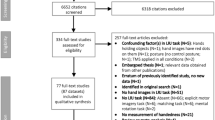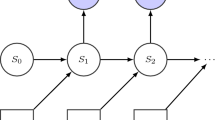Abstract
Although a limb's motion appears to be similar across unimanual and bimanual movements, here we demonstrate partial, but not complete, transfer of learning across these behavioral contexts, hidden learning that remains intact (but invisible) until the original context is again encountered, and the ability to associate two conflicting force fields simultaneously, one with each context. These results suggest partial, but not complete, overlap in the learning processes involved in the acquisition of unimanual and bimanual skills.



Similar content being viewed by others
References
Finch, M. Triathlon Training (Human Kinetics, Champaign, Illinois, 2004).
Scott, S.H. J. Neurosci. Methods 89, 119–127 (1999).
Shadmehr, R. & Mussa-Ivaldi, F.A. J. Neurosci. 14, 3208–3224 (1994).
Lackner, J.R. & Dizio, P. J. Neurophysiol. 72, 299–313 (1994).
Bagesteiro, L.B. & Sainburg, R.L. J. Neurophysiol. 88, 2408–2421 (2002).
Gandolfo, F., Mussa-Ivaldi, F.A. & Bizzi, E. Proc. Natl. Acad. Sci. USA 93, 3843–3846 (1996).
Osu, R., Hirai, S., Yoshioka, T. & Kawato, M. Nat. Neurosci. 7, 111–112 (2004).
Swinnen, S.P. Nat. Rev. Neurosci. 3, 348–359 (2002).
Carson, R.G. Brain Res. Brain Res. Rev. 49, 641–662 (2005).
Donchin, O. et al. J. Neurophysiol. 88, 3498–3517 (2002).
Kurtzer, I., Herter, T.M. & Scott, S.H. Nat. Neurosci. 8, 498–504 (2005).
Cunningham, C.L., Stoykov, M.E.P. & Walter, C.B. Acta Psychol. (Amst.) 110, 321–337 (2002).
Acknowledgements
We thank J.R. Flanagan, J.A. Pruszynski, T. Herter and T. Lillicrap for helpful comments, K. Moore for expert technical help, and N. Nozaki for preparation of the figures. This work was supported by a Japan Society for the Promotion of Science (JSPS) bilateral program and a JSPS Grant-in-Aid for Scientific Research (C, #18500456) to D.N., and a grant from the National Science and Engineering Research Council to S.H.S.
Author information
Authors and Affiliations
Contributions
This study was designed by all three authors. Data collection and data analysis were performed predominantly by D.N. All three authors contributed to the writing of the paper.
Corresponding authors
Ethics declarations
Competing interests
S.H.S. is the co-founder of BKIN Technologies, which commercializes the robotic technology used in this study.
Supplementary information
Rights and permissions
About this article
Cite this article
Nozaki, D., Kurtzer, I. & Scott, S. Limited transfer of learning between unimanual and bimanual skills within the same limb. Nat Neurosci 9, 1364–1366 (2006). https://doi.org/10.1038/nn1785
Received:
Accepted:
Published:
Issue Date:
DOI: https://doi.org/10.1038/nn1785
- Springer Nature America, Inc.
This article is cited by
-
Hand copy performance of young children and the illiterate, semi-illiterate, and literate adults
Current Psychology (2024)
-
Influence of switching rule on motor learning
Scientific Reports (2018)
-
Multiple motor memories are learned to control different points on a tool
Nature Human Behaviour (2018)
-
Active lead-in variability affects motor memory formation and slows motor learning
Scientific Reports (2017)
-
Balanced motor primitive can explain generalization of motor learning effects between unimanual and bimanual movements
Scientific Reports (2016)





